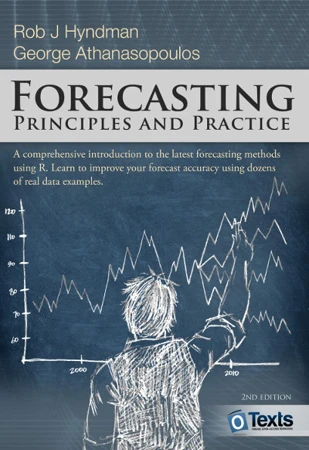Forecasting: principles and practice – A comprehensive introduction to the latest forecasting methods using R

Blurb
Forecasting is required in many situations. Stocking an inventory may require forecasts of demand months in advance. Telecommunication routing requires traffic forecasts a few minutes ahead. Whatever the circumstances or time horizons involved, forecasting is an important aid in effective and efficient planning.This textbook provides a comprehensive introduction to forecasting methods and presents enough information about each method for readers to use them sensibly.Book summary
The book provides an introduction to what forecasting is, in which cases it can be used, and how. The book goes through the characteristics of time series, the basic forecasting methods and the more advanced ones, based on judgment, regression, ARIMA models, etc. The last chapter covers some practical forecasting issues including seasonality, dealing with missing values, forecast combinations and backcasting. Through the book, examples are provided to illustrate each topic and codes in the R language are displayed to enable replication. Hence, this book also enables to learn how to realise forecasts using R. Finally, exercises are provided at the end of each chapter to train oneself.
Comment from our editors:
Most econometrics courses taught at university focus on cross-sectional and panel data without exploring the particularities of time series. When one wants to study the GDP across countries, there might be correlations that can be explained by adding characteristics, such as the size of the population, the age of the civilisation, etc. But when one wants to study the evolution of GDP across time in one country, no variable can be added because the correlation among the observations are due to time itself. When one wants to analyse the relations between GDP and each characteristics, using panel data, adding a time trend is sufficient, but when ones wants to understand the evolution across time, a time trend is no more sufficient. This book enables to dig into the particularities of time series, which are a special type of data, often misunderstood. It is a good book for beginners because, in the first chapter, the authors spend some time explaining deeply what forecasting means and what are the underlying principles behind it. It also explains that often naive forecasting is limited because past data cannot be informative, i.e. when a new product is launch, when a new type of crisis occurs, when a company enters a new country, etc. Therefore, additional methods should be mobilised to enhance forecasting. However, having some basic knowledge in econometrics smooths the reading. The book is very clear and well organised, enabling to move step-by-step deeper into forecasting. Finally, this book is available online for free and is updated continuously.

